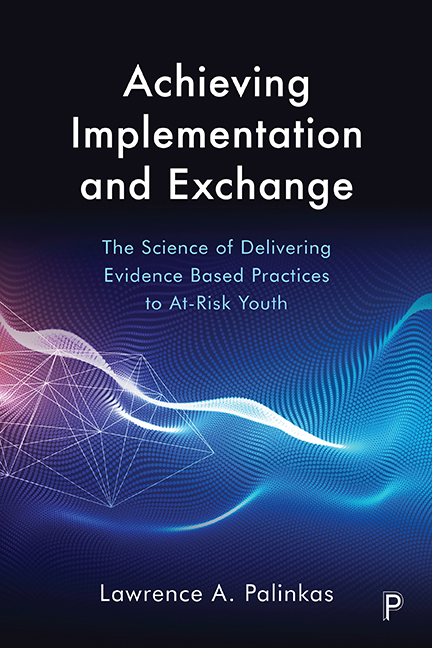 Achieving Implementation and Exchange
Achieving Implementation and Exchange Book contents
- Frontmatter
- Dedication
- Contents
- Tables and figures
- Abbreviations
- Preface
- 1 Introduction
- 2 The need for evidence-based practice
- 3 Understanding and reducing the gap
- 4 EBP implementation in child welfare and child mental health
- 5 Social networks and EBP implementation
- 6 Use of research evidence and EBP implementation
- 7 Local models of EBP implementation
- 8 Research–practice–policy partnerships
- 9 Cultural exchange and EBP implementation
- 10 A transactional model of implementing EBP
- References
- Index
3 - Understanding and reducing the gap
Published online by Cambridge University Press: 13 April 2022
- Frontmatter
- Dedication
- Contents
- Tables and figures
- Abbreviations
- Preface
- 1 Introduction
- 2 The need for evidence-based practice
- 3 Understanding and reducing the gap
- 4 EBP implementation in child welfare and child mental health
- 5 Social networks and EBP implementation
- 6 Use of research evidence and EBP implementation
- 7 Local models of EBP implementation
- 8 Research–practice–policy partnerships
- 9 Cultural exchange and EBP implementation
- 10 A transactional model of implementing EBP
- References
- Index
Summary
So, the key to these systems is not the clinical work, necessarily, it is the implementation process to make sure, first of all, that they are correctly diagnosed, and second of all, that the model is correctly implemented and people are well trained and they do it correctly, not doing part of it. Do part of it and you can't measure it, and you don't know why they got better. And so that is why I think we implement these models, when we’re doing it correctly, I see people get really excited and they get really good at doing it, and they start understanding why it has to be done correctly and people start getting better, and it's an amazing thing to watch because you’re doing a particular model and the kid actually gets better, when you’re a probation officer or a social worker and you’ve done it for thirty years and you’ve never seen anybody get better because of something somebody did, it's an amazing thing to watch. (Mental health services director)
As noted in the last chapter, despite the existence of numerous EBPs for prevention and treatment of mental and behavioral health problems in youth, fewer than one in five youth in need of such EBPs actually receive them. Given that one in every three to five youth are in need of such services at some point in their lives, the disconnect between supply of EBPs and demand for them is concerning. Identifying the barriers to successful EBP implementation and sustainment and application of evidence-based strategies to overcome these barriers are the aims of implementation science.
In this chapter, we examine common barr iers to EBP implementation found in most systems of care that help to explain why EBP implementation has enjoyed limited success in child welfare and child mental health to date. We then introduce the four pillars underlying implementation science; 1) theories, models and frameworks that identify and explain the associations between potential predictors and outcomes of implementation efforts; 2) discrete and multifaceted strategies for achieving positive implementation outcomes; 3) measures for assessing implementation process and outcomes; and 4) innovative methods for implementation science such as mixed methods, hybrid and alternative experimental designs, and systems science methods.
- Type
- Chapter
- Information
- Achieving Implementation and ExchangeThe Science of Delivering Evidence-Based Practices to At-Risk Youth, pp. 33 - 58Publisher: Bristol University PressPrint publication year: 2018
